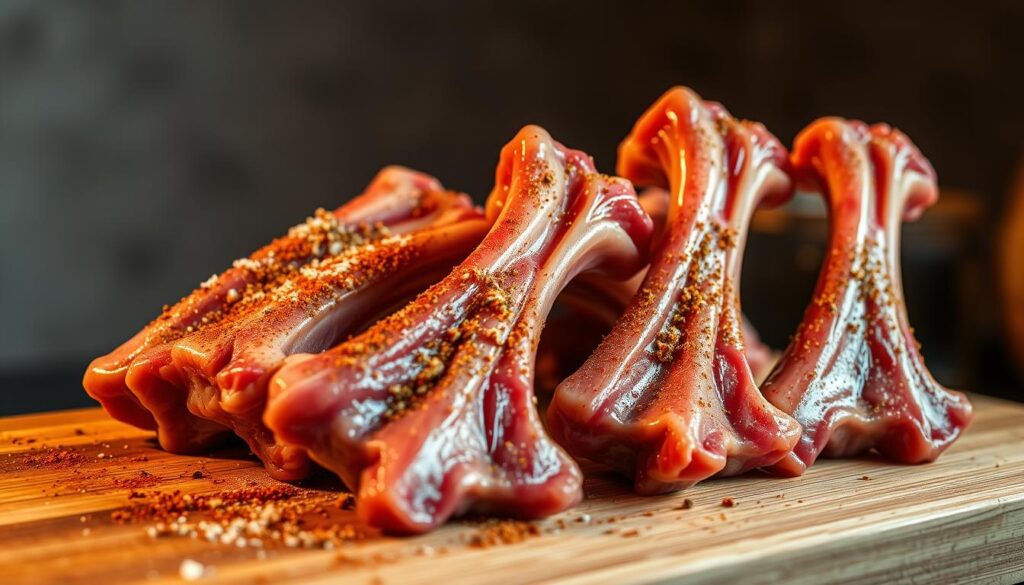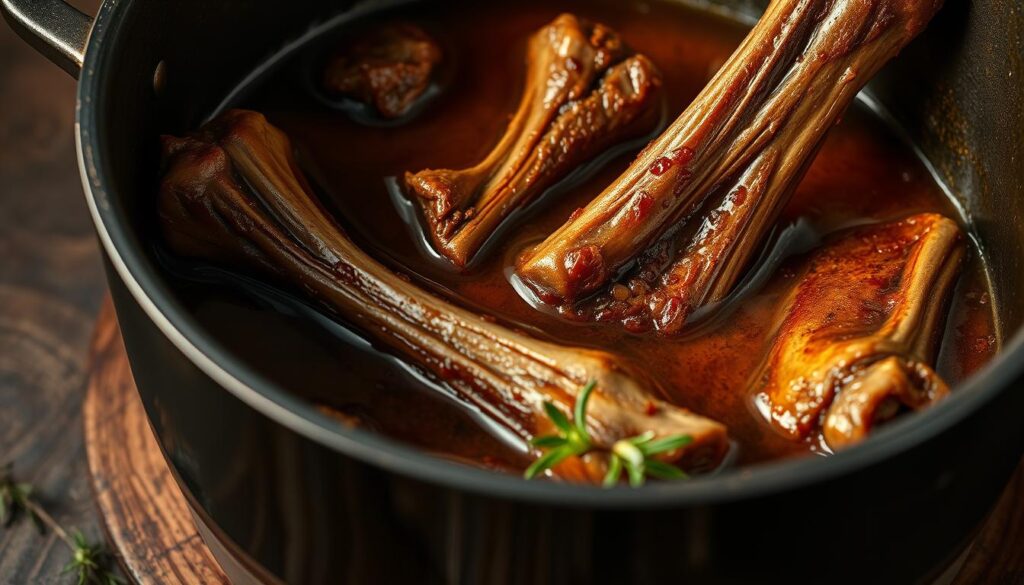Beef Neck Bones Recipe: Tender, Juicy, and Flavorful
Every kitchen has its hidden treasures, and the beef neck bones recipe is one such gem. Growing up, I watched my grandmother turn these tough cuts into a feast. It brought our family together at dinner.
Slow-cooked beef has a magical way of melting hearts and creating memories. This dish isn’t just a recipe—it’s a journey. It transforms humble ingredients into a rich, tender meal that touches your soul.
Whether you’re a seasoned cook or new to traditional cooking, this recipe will surprise you. It unlocks deep, robust flavors that will delight your taste buds.
Table of Contents
Understanding Beef Neck Bones: A Hidden Culinary Gem
Beef neck bones are a hidden gem in the kitchen. They offer great flavor and nutrition at a low cost. These affordable protein sources can make your cooking more exciting.
Beef neck bones are packed with nutrients. They are high in protein, minerals, and collagen. This makes them a great choice for your meals. Cooking with them can make your dishes taste amazing and save money.
Nutritional Powerhouse
- High protein content: Approximately 20-25 grams per serving
- Rich in essential minerals like iron and zinc
- Excellent source of collagen for joint health
- Low-cost protein alternative to premium cuts
Why Choose Neck Bones for Cooking
Beef neck bones are perfect for slow-cooking. They are great for braising and stewing. The meat becomes tender and full of flavor.
Selection and Preparation Tips
When picking beef neck bones, look for lean cuts. They should be fresh and have a pinkish-red color. A firm texture is also important.
- Choose bones with some meat attached
- Check for consistent color and minimal discoloration
- Ask your butcher about recent processing dates
- Consider organic or grass-fed options for enhanced nutrition
Pro tip: Neck bones shine in slow-cooker recipes, making them perfect for home cooks seeking delicious, budget-friendly meals.
Essential Ingredients for Perfect Beef Neck Bones
Starting to make delicious beef neck bones is all about picking the right ingredients. Your journey in the kitchen begins with knowing the key parts that turn these simple cuts into a tasty meal.
The main ingredients for beef neck bones are the base of your dish. You’ll need to gather these essential items:
- Beef neck bones (4-5 pounds, preferably fresh and well-trimmed)
- Kosher salt (2-3 tablespoons)
- Fresh ground black pepper
- Garlic cloves (4-5, minced)
- Yellow onions (2 large, chopped)
Seasoning for neck bones is key to rich, deep flavors. A great mix will make the meat go from good to great. Here are some seasoning options:
- Paprika
- Dried thyme
- Bay leaves
- Worcestershire sauce
- Apple cider vinegar
Pro tip: Choose beef neck bones with good marbling and a fresh look. The fat helps keep the meat tender during long cooking. Using quality ingredients is the secret to a dish that will leave everyone wanting more.
Kitchen Equipment and Tools Needed
Preparing beef neck bones needs special cooking gear for slow cooking. Your kitchen setup is key to making these tough cuts tender and tasty.
For slow cooking, you’ll need some must-have tools. The right tools can greatly improve your cooking and the dish’s quality.
Recommended Cooking Vessels
Choosing the right cooking vessel is important for beef neck bones. Here are your best options:
- Dutch Oven: Heavy-cast iron with excellent heat retention
- Slow Cooker: Perfect for hands-off, low-temperature cooking
- Large Heavy-Bottom Pot: Provides even heat distribution
Additional Kitchen Tools
Get these essential tools to make cooking easier:
- Meat thermometer for precise temperature tracking
- Sharp kitchen tongs for handling meat
- Cutting board for raw meats
- Sturdy kitchen gloves for safety
Temperature Control Essentials
Keeping a steady temperature is vital for tender beef neck bones. Use digital thermometers for real-time readings. This ensures perfect tenderness every time.
Quality cooking gear for beef neck bones will boost your cooking skills. It makes delicious meals with less effort.
Preparation and Seasoning Techniques

Preparing beef neck bones needs careful attention and the right seasoning. The right techniques can turn these cuts into a dish that wows your guests. Before cooking, making sure the bones are ready is key for flavor and tenderness.
Start by cleaning the meat well. Rinse the neck bones under cold water and dry them with paper towels. This removes bone fragments and makes the cooking surface clean.
Essential Seasoning Techniques
- Use kosher salt and freshly ground black pepper as your base seasoning
- Create a dry rub with paprika, garlic powder, and dried herbs
- Consider marinating neck bones for deeper flavor penetration
Seasoning neck bones can depend on what you like. A classic way is to coat the meat with spices that match its rich taste.
| Seasoning Type | Flavor Profile | Recommended Spices |
|---|---|---|
| Classic | Traditional | Salt, Black Pepper, Thyme |
| Spicy | Bold | Cayenne, Chili Powder, Cumin |
| Herbal | Aromatic | Rosemary, Sage, Oregano |
Pro tip: Let seasoned beef neck bones rest at room temperature for 30 minutes before cooking. This lets the spices soak into the meat and helps cook evenly.
Remember, the right seasoning is essential for bringing out the rich flavors of beef neck bones. Try different spice mixes to find your favorite.
Step-by-Step Beef Neck Bones Recipe
Cooking beef neck bones needs patience and care. This guide will show you how to make a tasty, tender meal. It will impress your family and friends.
Getting ready to cook beef neck bones is important. First, make sure you have all your ingredients and tools ready. This will make cooking easier.
Initial Preparation Steps
- Select fresh, high-quality beef neck bones from your local butcher
- Rinse the neck bones thoroughly under cold water
- Pat the meat dry with paper towels to ensure proper browning
- Season generously with salt and black pepper
Cooking Process Guide
For perfect beef neck bones, cook them slowly. Start by heating a heavy pot or Dutch oven over medium-high heat. Sear the neck bones until they develop a rich, golden-brown crust. This step adds flavor and makes the dish delicious.
Temperature and Timing Guidelines
| Cooking Stage | Temperature | Approximate Time |
|---|---|---|
| Initial Searing | Medium-High (375°F) | 4-5 minutes per side |
| Slow Cooking | Low (250°F) | 2-3 hours |
| Final Resting | Room Temperature | 10-15 minutes |
Cooking beef neck bones is an art that needs low and slow heat. After searing, lower the heat to low. Add liquid like beef broth or wine, cover the pot, and let it cook. The meat will become so tender it will melt in your mouth.
Braising Tips for Maximum Tenderness

Learning to braise beef neck bones takes time and knowledge of meat science. It turns a tough cut into a tender, delicious dish. The secret to tender meat is slow, low-heat cooking.
To tenderize neck bones, choose the right cooking method. The moist, slow heat breaks down tough tissues. This makes the meat soft and falls off the bone.
- Keep liquid levels consistent during braising
- Maintain low, steady temperatures between 275-325°F
- Cook for extended periods (2-4 hours)
- Use enough liquid to cover meat partially
Your braising technique should focus on tenderizing neck bones through gentle, prolonged cooking. Cover your pot or Dutch oven tightly to trap moisture and ensure even heat distribution. Check the meat periodically, adding liquid if needed to prevent drying.
Professional chefs suggest using aromatic vegetables and rich stocks to enhance flavor while braising beef neck bones. The longer you cook, the more tender the meat becomes, so resist the urge to rush the process.
Sauce and Gravy Preparation
Making the perfect sauce for neck bones takes your dish to the next level. A great beef neck bones gravy can make your meal feel like a fancy restaurant experience at home.
The secret to a top-notch sauce is to catch the deep flavors from cooking. Your gravy should enhance the meat’s tenderness and add more flavor.
Classic Gravy Recipe
To make a classic beef neck bones gravy, you’ll need a few key ingredients:
- Pan drippings from cooked neck bones
- All-purpose flour
- Beef broth
- Salt and pepper
- Optional herbs like thyme or rosemary
Begin by straining the pan drippings and getting rid of extra fat. Mix flour into the remaining liquid to make a roux. This will thicken your gravy. Slowly add beef broth, stirring constantly to avoid lumps.
Flavor Enhancement Options
Boost your beef neck bones gravy with these creative touches:
- Red wine reduction for depth and complexity
- Minced garlic for extra aromatics
- Worcestershire sauce for umami flavor
- Roasted vegetable puree for richness
The best sauce for neck bones balances the meat’s strong flavor. It should also add moisture and excitement. Try different methods to create your own unique gravy.
Side Dish Pairing Suggestions
Choosing the right side dishes for beef neck bones can make your meal amazing. The rich flavor of neck bones needs sides that match its taste and add nutrition.
Here are some classic side dishes that will make your meal better:
- Creamy mashed potatoes
- Buttery rice pilaf
- Roasted seasonal vegetables
- Collard greens or braised greens
- Cornbread or buttermilk biscuits
The secret to great side dishes for beef neck bones is mixing textures and tastes. Starchy sides soak up meat juices, while veggies add freshness and nutrients.
| Side Dish Category | Best Pairing Options | Flavor Profile |
|---|---|---|
| Starches | Mashed potatoes, white rice | Creamy, mild |
| Vegetables | Roasted carrots, green beans | Crisp, earthy |
| Breads | Cornbread, dinner rolls | Warm, comforting |
Pro tip: Pick sides that can soak up the rich gravy from your beef neck bones. This way, you won’t miss out on any flavor and your meal will be even more enjoyable.
Storage and Reheating Guidelines
Keeping beef neck bones tasty and tender needs the right storage and reheating. Follow these tips to enjoy your meal over and over, keeping it safe and delicious.
Best Practices for Storing Beef Neck Bones
Here’s how to store beef neck bones right:
- Cool the meat completely before storing
- Use airtight containers or heavy-duty freezer bags
- Refrigerate within two hours of cooking
- Store in the refrigerator for up to 3-4 days
- For longer storage, freeze for up to 3 months
Effective Reheating Techniques
Reheating neck bones gently keeps them tender and moist. Try these methods:
- Oven Method:
- Preheat oven to 325°F
- Place neck bones in an oven-safe dish
- Add a small amount of broth or water
- Cover with foil to retain moisture
- Heat for 20-25 minutes until warmed through
- Stovetop Method:
- Use a covered skillet
- Add a splash of broth
- Heat on low temperature
- Stir occasionally to prevent sticking
- Warm for 10-15 minutes
Pro tip for storing beef neck bones: Always label your containers with the date of storage to track freshness. When reheating neck bones, check the internal temperature reaches 165°F to ensure food safety.
Troubleshooting Common Cooking Issues
Cooking beef neck bones can sometimes be tricky. Knowing how to fix common problems helps you make tender meat every time.
When meat is tough, try a different cooking method. Slow, low-temperature cooking breaks down connective tissues. This makes the meat tender and delicious. Fixing recipe issues often takes patience and the right techniques.
- Tough Meat Solution: Cook neck bones at 275-300°F for 3-4 hours to ensure tenderness
- Flavor Enhancement: Use robust seasonings like garlic, bay leaves, and black pepper
- Liquid Management: Maintain adequate moisture without drowning the meat
If there’s too much liquid, remove the lid in the last hour. This helps reduce the liquid and concentrate flavors. Remember, each cut might need slight technique changes.
Temperature control is key. Use a meat thermometer to check for 195-205°F. This ensures the meat is tender and falls apart easily. Understanding these basics makes fixing recipe issues simple.
Conclusion
Mastering a beef neck bones recipe takes patience, passion, and practice. You’ve learned that this often-overlooked cut can become a remarkable dish. Your kitchen skills have grown, allowing you to make a meal that’s both comforting and flavorful.
Enjoying a neck bones dish means embracing creativity and tradition. Every time you make this recipe, you’ll find new flavors and techniques. Feel free to try different seasonings, cooking methods, and sides to enhance the beef neck bones’ rich taste.
Your newfound skills turn a simple ingredient into a meal that wows family and friends. Remember, cooking is a journey of learning. Trust your instincts and enjoy the tasty results of your kitchen efforts.
We encourage you to share your beef neck bones cooking stories, ask questions, and keep exploring home cooking. Your culinary journey is just starting, and each recipe is a chance to grow and enjoy delicious meals.
FAQ
What are beef neck bones, and why are they a good choice for cooking?
How long does it take to cook beef neck bones until they’re tender?
What are the best cooking methods for beef neck bones?
Can I freeze beef neck bones before or after cooking?
What are some good side dishes to serve with beef neck bones?
How do I know when beef neck bones are fully cooked?
Are beef neck bones nutritious?
What seasonings work best with beef neck bones?
Can I make beef neck bones in a pressure cooker?
How can I prevent beef neck bones from becoming dry?
There are no reviews yet. Be the first one to write one.

